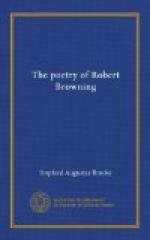But when it was done, art claimed its place in this work. The desire sprang up among historians to conceive all this history in the imagination, to shape vividly its scenery, to animate and individualise its men and women, to paint the life of the human soul in it, to clothe it in flesh and blood, to make its feet move and its eyes flash—but to do all these things within the limits of the accurate knowledge which historical criticism had defined. “Let us saturate ourselves,” said the historians, “with clear knowledge of the needful facts, and then, without violation of our knowledge, imagine the human life, the landscape, the thinking and feeling of a primaeval man, of his early religion, of his passions; of Athens when the Persian came, of Rome when the Republic was passing into the Empire, of a Provincial in Spain or Britain, of a German town in the woods by the river. Let us see in imagination as well as in knowledge an English settlement on the Welsh border, an Italian mediaeval town when its art was being born, a Jewish village when Christ wandered into its streets, a musician or a painter’s life at a time when Greek art was decaying, or when a new impulse like the Renaissance or the French Revolution came upon the world.” When that effort of the historians had established itself, and we have seen it from blossoming to fruitage, people began to wonder that no poet had ever tried to do this kind of work. It seemed eminently fitted for a poet’s hand, full of subjects alluring to the penetrative imagination. It needed, of course, some scholarship, for it demanded accuracy in its grasp of the main ideas of the time to be represented; but that being given, immense opportunities remained for pictures of human life, full of colour, thought and passions; for subtle and brilliant representations of the eternal desires and thinkings of human nature as they were governed by the special circumstances of the time in which the poem was placed; and for the concentration into a single poem, gathered round one person, of the ideas whose new arrival formed a crisis in the history of art.
Men looked for this in Tennyson and did not find it. His Greek and mediaeval poems were modernised. Their imaginative work was uncritical. But when the historians and the critics of art and of religious movements happened at last to look into Browning, they discovered, to their delight and wonder, that he had been doing, with a curious knowledge, this kind of work for many years. He had anticipated the results of that movement of the imagination in historical work which did not exist when he began to write; he had worked that mine, and the discovery of this made another host of people readers of his poetry.
We need scarcely give examples of this. Sordello, in 1840 (long before the effort of which we speak began), was such a poem—the history of a specialised soul, with all its scenery and history vividly mediaeval. Think of the Spanish Cloister, The Laboratory, A Grammarian’s Funeral, the Bishop orders his Tomb at Saint Praxed’s Church, poems, each of which paints an historical period or a vivid piece of its life. Think of The Ring and the Book, with all the world of Rome painted to the life, and all the soul of the time!




